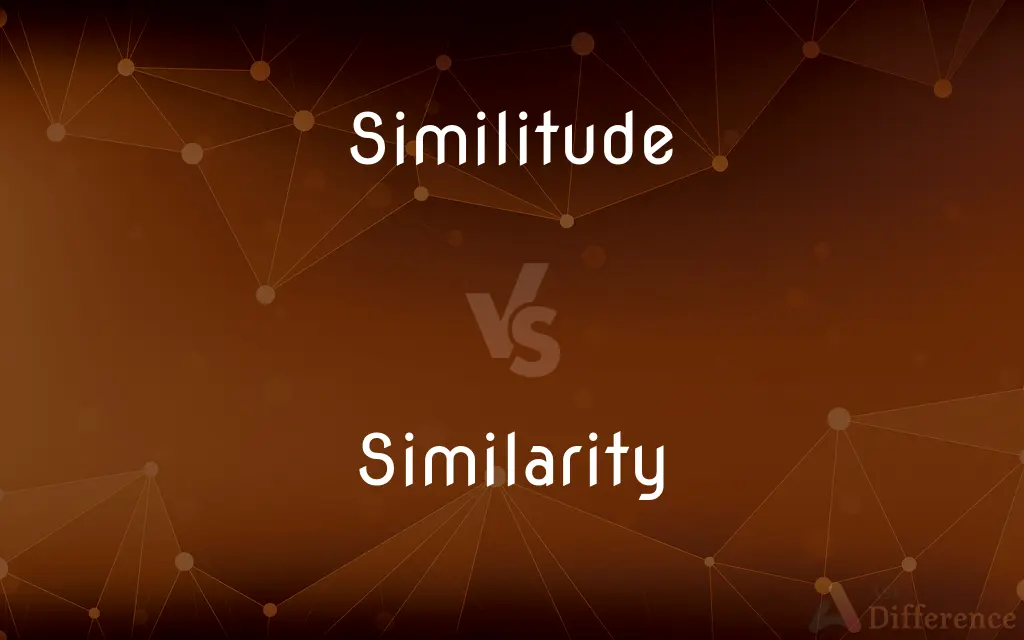Similitude vs. Similarity — What's the Difference?
By Urooj Arif & Maham Liaqat — Updated on April 14, 2024
Similitude refers to a figurative or symbolic likeness, often used in literary contexts, while similarity denotes a general likeness in appearance, function, or nature.

Difference Between Similitude and Similarity
Table of Contents
ADVERTISEMENT
Key Differences
Similitude is typically used to describe a metaphorical or allegorical resemblance between two things, often emphasizing a deeper or conceptual connection. On the other hand, similarity refers to more straightforward comparisons based on observable attributes or shared characteristics.
In literary analysis, similitude might be employed to draw parallels between thematic elements across different works, suggesting a shared motif or message. Conversely, similarity could be used to discuss more direct parallels, such as similar plot points or character traits in literature.
Philosophically, similitude can relate to abstract qualities or ideas that seem to mirror each other, enhancing the richness of interpretation. Meanwhile, similarity is often utilized in scientific contexts to denote measurable or empirical likenesses between objects or phenomena.
When used in religious texts, similitude might describe symbolic representations that point to a higher truth or moral lesson. In contrast, similarity in such texts might simply point to commonalities in stories or teachings across different cultures or eras.
In everyday language, similitude is less commonly used and retains a formal or scholarly tone, whereas similarity is widely used and understood, applicable to a variety of everyday situations and comparisons.
ADVERTISEMENT
Comparison Chart
Usage Context
Literary, philosophical, religious
General, scientific, everyday
Connotation
Figurative, symbolic
Direct, observable
Commonness of Usage
Less common, more formal
Common, widely used
Emphasis
Conceptual or metaphorical connections
Empirical or observable likenesses
Typical Disciplinary Use
Literature, theology, philosophy
Science, mathematics, general discussion
Compare with Definitions
Similitude
A figurative or metaphorical resemblance.
The similitude between the journey of life and a river’s course is often explored in poetry.
Similarity
Often used in scientific contexts to describe comparable traits.
The similarity in genetic sequences suggests a common ancestor.
Similitude
A resemblance that emphasizes conceptual connections.
The similitude between modern and ancient democracies can be seen in their foundational philosophies.
Similarity
A general likeness or resemblance between two entities.
The similarity between twins can sometimes be uncanny.
Similitude
A representation that suggests a likeness in allegories.
The similitude of light and knowledge is common in philosophical texts.
Similarity
An attribute that makes one thing comparable to another.
The similarity in their methods yielded equally successful results.
Similitude
A symbolic likeness used to convey deeper meanings.
Medieval alchemists used the similitude of base metals turning into gold as a spiritual metaphor.
Similarity
A state of being alike in some manner or aspect.
The similarity of their conclusions highlights the robustness of the experiment.
Similitude
A comparative expression in literary analysis.
Critics note the similitude in themes of exile in Shakespeare’s plays.
Similarity
Commonly used in everyday contexts to express resemblance.
Their similarity in taste made them good friends.
Similitude
That which is like or similar; a representation, semblance, or copy; a facsimile.
Man should wed his similitude.
Similarity
The quality or condition of being similar; resemblance.
Similitude
Similarity; resemblance
"Not every case of similitude in nature is proof of a close bloodline" (Natalie Angier).
Similarity
A corresponding aspect or feature; equivalence
A similarity of writing styles.
Similitude
(Archaic) One that closely resembles another.
Similarity
Closeness of appearance to something else.
Similitude
(Archaic) A simile, allegory, or parable.
Similarity
(philosophy) The relation of sharing properties.
Similitude
(uncountable) Similarity or resemblance to something else.
Similarity
(maths) A transformation that preserves angles and the ratios of distances
Similitude
(countable) A way in which two people or things share similitude.
Similarity
The property of two matrices being similar.
Similitude
(countable) Someone or something that closely resembles another; a duplicate or twin.
Similarity
The quality or state of being similar; likeness; resemblance; as, a similarity of features.
Hardly is there a similarity detected between two or three facts, than men hasten to extend it to all.
Similitude
A parable or allegory.
Similarity
The quality of being similar
Similitude
The quality or state of being similar or like; resemblance; likeness; similarity; as, similitude of substance.
Let us make now man in our image, manIn our similitude.
If fate some future bard shall joinIn sad similitude of griefs to mine.
Similarity
A Getalt principle of organization holding that (other things being equal) parts of a stimulus field that are similar to each other tend to be perceived as belonging together as a unit
Similitude
The act of likening, or that which likens, one thing to another; fanciful or imaginative comparison; a simile.
Tasso, in his similitudes, never departed from the woods; that is, all his comparisons were taken from the country.
Similitude
Similarity in appearance or character or nature between persons or things;
Man created God in his own likeness
Similitude
A duplicate copy
Common Curiosities
How is similitude different from similarity?
Similitude is often more figurative and used in symbolic or metaphorical contexts, whereas similarity is a broader term used for observable likenesses.
Can similitude and similarity be used interchangeably?
While they can sometimes be used interchangeably in a broad sense, similitude often carries a more specific, symbolic meaning.
Where is similitude most commonly used?
It is most commonly used in literary, philosophical, or religious contexts to convey metaphorical or allegorical connections.
What is similarity?
Similarity refers to a general likeness or resemblance in appearance, function, or nature.
Is similarity more common in scientific contexts?
Yes, similarity is often used in scientific and empirical studies to describe measurable or observable likenesses.
What is similitude?
Similitude is a term used to describe a figurative or symbolic resemblance, often emphasizing deeper or conceptual connections.
How does similitude enhance the understanding of texts?
Similitude can enhance understanding by highlighting deeper, symbolic relationships that might not be immediately apparent, adding layers of interpretation.
Can similarity have a quantitative aspect?
Yes, in scientific contexts, similarity can be measured and quantified, such as in genetic similarity or geometric similarity.
Is similitude used in everyday language?
Similitude is less commonly used in everyday language and tends to appear more in scholarly or formal texts.
How do literary critics use the term similitude?
Literary critics might use similitude to discuss the metaphorical connections between themes, motifs, or narratives across different works.
Does similitude imply a deeper connection than similarity?
Typically, yes. Similitude often implies a deeper, sometimes symbolic connection between things.
What are examples of similarity in everyday life?
Examples include the similarity in appearance between siblings, in design between different brands of cars, or in flavor between different types of apples.
Can the concept of similarity apply to abstract ideas?
Yes, similarity can also apply to abstract ideas, such as similar political ideologies or theories.
Does similarity always imply a positive connection?
Not necessarily; similarity simply denotes likeness, which can be neutral or negative depending on the context.
What makes similitude a less common term than similarity?
Its more specialized use in symbolic and allegorical contexts makes it less common than the broadly applicable term similarity.
Share Your Discovery

Previous Comparison
Ogre vs. Elf
Next Comparison
Gazelle vs. SpringbokAuthor Spotlight
Written by
Urooj ArifUrooj is a skilled content writer at Ask Difference, known for her exceptional ability to simplify complex topics into engaging and informative content. With a passion for research and a flair for clear, concise writing, she consistently delivers articles that resonate with our diverse audience.
Co-written by
Maham Liaqat













































